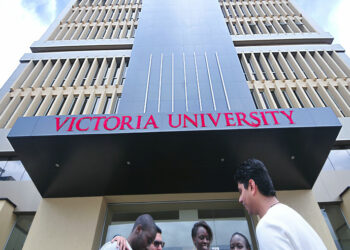The Minister of Tourism, Wildlife, and Antiquities, Hon. Tom R. Butime, has unveiled significant achievements and ongoing efforts in implementing the NRM Manifesto (2021–2026) commitments to transform Uganda into a leading global tourism destination.
During the NRM Manifesto week, Minister Butime outlined milestones showcasing the government’s dedication to improving the sector while addressing the challenges that hinder its full potential.
Key accomplishments include the completion of major infrastructure projects designed to enhance the country’s tourism offering. The Crested Crane Training Application Hotel at the Uganda Hotel and Tourism Training Institute (UHTTI) in Jinja stands as a modern facility for advanced hospitality skills.
Similarly, the new Uganda Wildlife Research and Training Institute (UWRTI) campus in Kasese is equipped to deliver internationally competitive training to a growing pool of professionals in the sector. Investments in the Rwenzori Mountains, such as newly constructed climbing ladders, boardwalks, and improved camp facilities, are set to attract more adventure enthusiasts to the region.
In a bid to boost conservation efforts, the government has intensified the management of protected areas. A key highlight was the recruitment of 855 additional rangers and the installation of 106.7 kilometres of electric fencing to mitigate human-wildlife conflict. Meanwhile, efforts to protect the iconic gorilla population in Mgahinga National Park have been reinforced, underlining Uganda’s commitment to preserving its unique biodiversity for future generations.
The Ministry has, however, faced several challenges in fulfilling its commitments. Limited marketing and inadequate visibility of Uganda’s tourism brand were identified as significant obstacles, compounded by natural calamities and health emergencies such as Ebola outbreaks and floods. Infrastructure gaps, particularly poor road networks and insufficient internet access in protected areas continue to undermine tourist experiences. Despite these hurdles, the government has taken decisive steps, including fast-tracking the development of a comprehensive national tourism marketing strategy and investing in critical road and airport infrastructure. Notably, Kabalega International Airport, now 95 per cent complete, is poised to bolster accessibility to key tourism zones.
Another pressing concern raised by the Minister was the lack of skilled manpower in the sector, which affects service delivery. To address this, the government has prioritized upgrading training institutions, with UHTTI and UWRTI positioned to produce highly skilled professionals capable of meeting international standards.
Efforts to diversify Uganda’s tourism portfolio also featured prominently. Recognizing an overreliance on wildlife attractions, the Ministry has proposed increased investment in artificial and animated attractions to enhance competitiveness within the regional tourism market. In parallel, the government has provided private investors with affordable credit options through the Uganda Development Bank to encourage the development of accommodation facilities and other tourism-related ventures.
Despite financial constraints, Hon. Butime emphasized the significant progress made on 11 of the 16 tourism-related commitments, with two already fully achieved. He expressed optimism that most targets would be met by 2026, although three commitments remain at risk due to low development budget allocations. The Minister underscored the importance of sustained government and private sector collaboration in addressing the remaining challenges.
He reiterated that tourism is a key pillar of Uganda’s economic transformation, serving not only as a source of revenue but also as a vehicle to showcase the country’s cultural and natural wealth to the world. With ongoing initiatives and reforms, Uganda’s tourism sector is on track to achieve even greater success in the years to come.
Do you have a story in your community or an opinion to share with us: Email us at editorial@watchdoguganda.com













